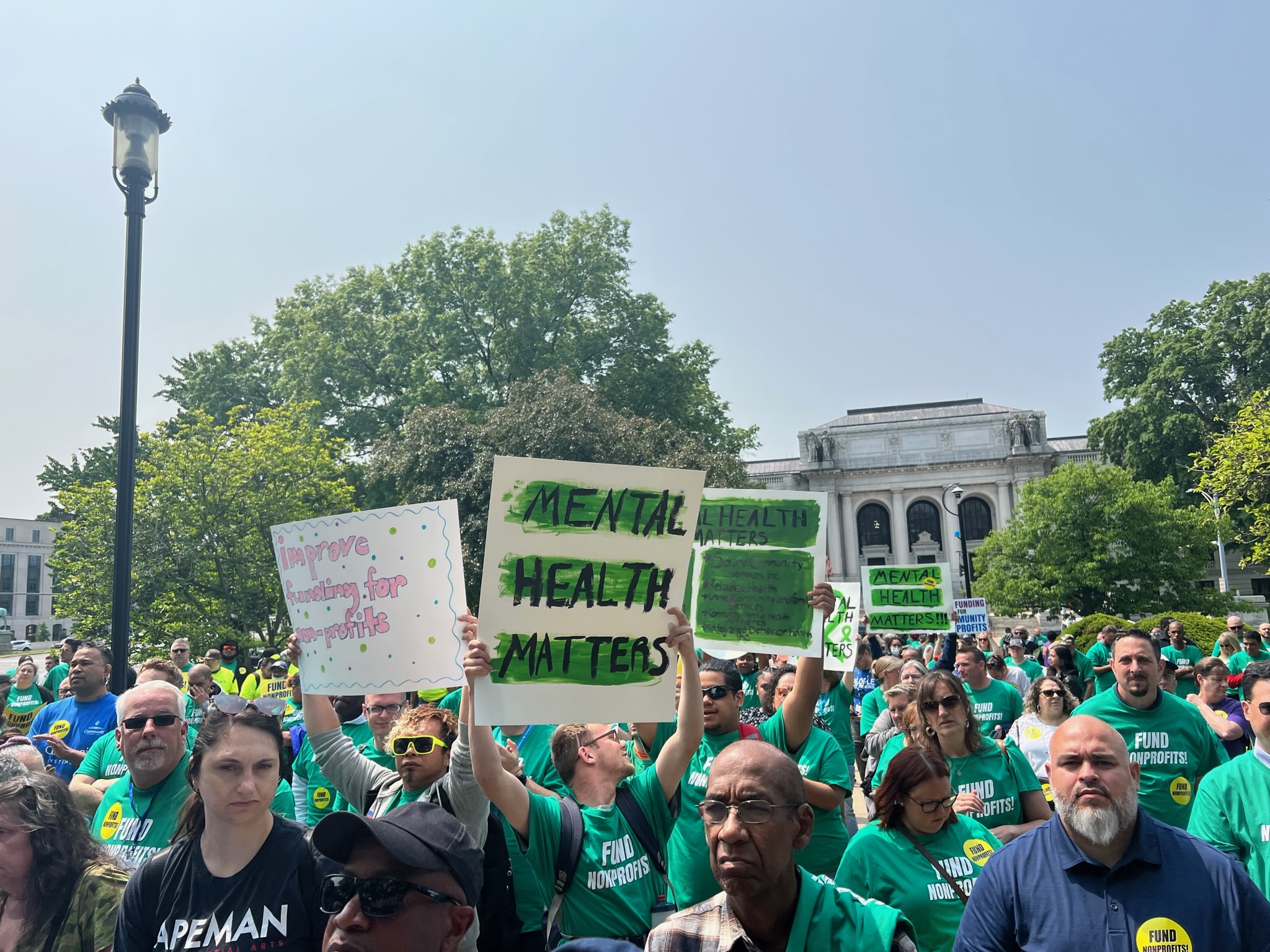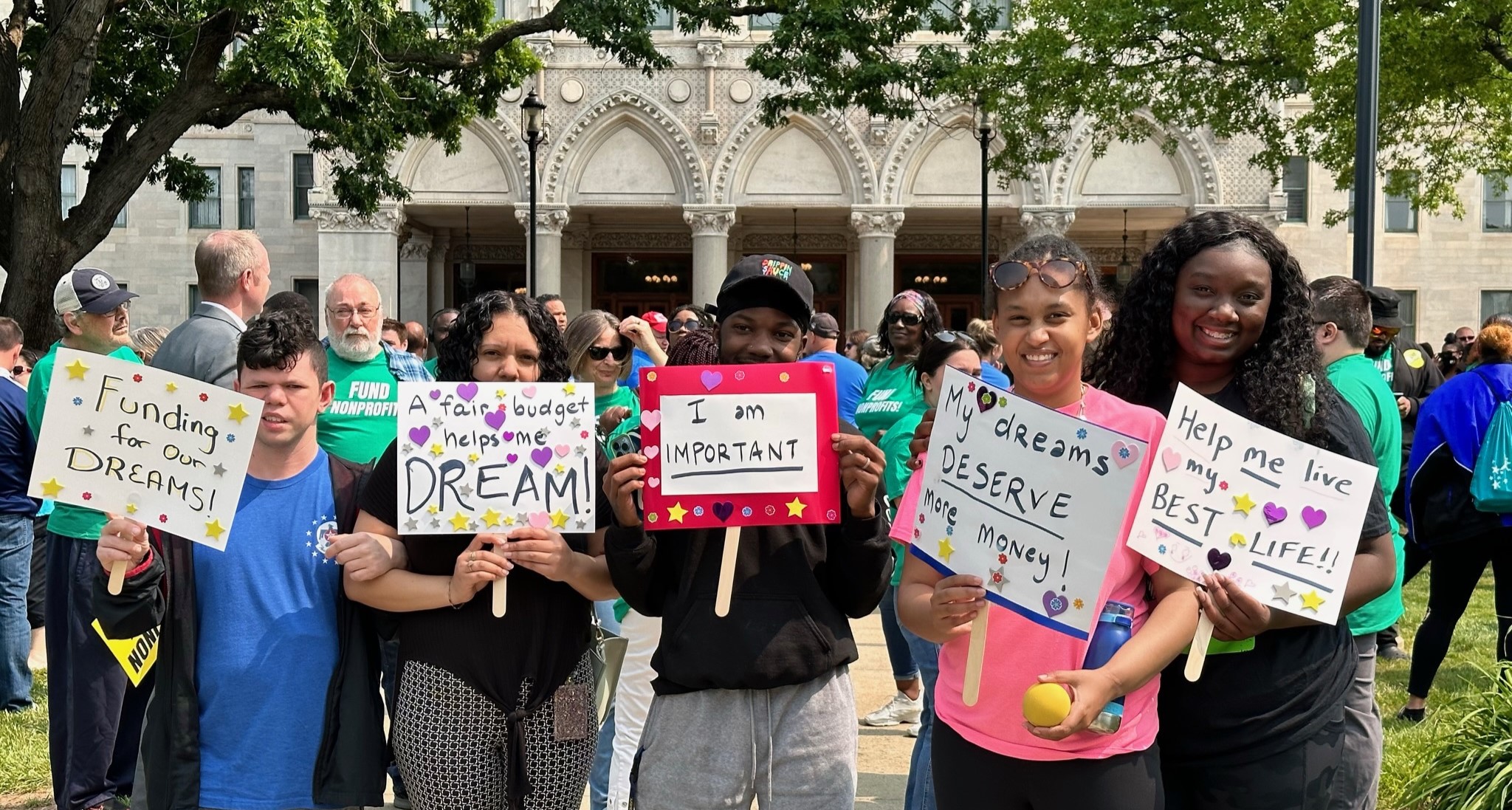Increase Funding for Community Nonprofits
Historic State Budget Surpluses Make Increases Possible
Connecticut is projecting a budget surplus of more than one hundred million dollars this year, next year, and every year in the future. These surpluses grow with our economy, which continues to experience significant growth and expansion. And they grow with a Budget Reserve Fund that has been funded at its statutory cap each of the last four years.
The state budget is healthier than ever – yet nonprofits continue to be in crisis, with an unprecedented workforce shortage, increased essential costs, and skyrocketing demand for community services. And with the minimum wage automatically increasing each year, nonprofit funding must follow suit so they can stay competitive. Instead of moving more quickly along the path to funding increases for the essential services that nonprofits provide to half a million Connecticut residents, policymakers have chosen to spend billions paying off a small portion of the state’s long-term debt obligations. Without a change, policymakers will keep making this choice each year.
The legislature should support nonprofits and increase funding by 5%, after providing $50 million to health and human services providers that did not receive the DDS-specific bonus funds in the FY24 budget, a total increase of $186 million. This increase should include Medicaid rates for nonprofit services. After the biennium, the legislature should index future nonprofit funding to inflation.


Act Now! Contact Your Legislator
Please send your legislators a message asking them to support community nonprofits.
We encourage you to edit the pre-loaded message to reflect your own story and unique perspective.
In Their Own Words
“The cost to attract and retain staff is difficult to manage. We can’t remain competitive in the labor market with contract revenues that don’t support increases. Fuel, food, supplies all went up in cost. Contractors are raising prices because they can.”
“The biggest single impact [of inflation] is staffing and the increased competition with other industries and inability to compete with salaries. [We] were already on the verge of a staffing crisis and COVID over the last few years has magnified the issues and perpetuated the crisis.”
“Our staff are suffering with the inflation they are experiencing at home, the increases we received for them did not cover inflation. Several of them left and took jobs with the State or in other industries which pay more and work less, some from home.”
“We were unable to afford a satellite office in western CT – closed the office, reassigned staff to other units, referred clients to provider 25 miles away.”
“We are not able to provide services to everyone. Employees are leaving because they are stuck on shift and working too many hours. Our staff are discouraged and voicing this.”
“Demand has increased for the intensity and frequency of service. We have a three-week waiting list for an assessment and another week for new clients to be seen by a clinician.”
Recommendation for Policymakers
The legislature should increase funding by 5%, after providing $50 million to health and human services providers that did not receive the DDS-specific bonus funds in the FY24 budget, a total increase of $186 million. This increase should include Medicaid rates for nonprofit services. After the biennium, the legislature should index future nonprofit funding to inflation.
Nonprofits Improve Our Quality Of Life
Policymakers can make a direct and sustained positive impact on Connecticut if they invest in community nonprofits. Nonprofits are major employers in the state, with 118,000 employees, about eight percent of the workforce. With continued investment from the state, nonprofits could:
- Increase salaries and provide better benefits for hard working staff, keeping pace with competition from other industries and states;
- Innovate and expand, serving more people in new and better ways;
- Better meet the needs of Connecticut’s residents, improving the quality of life and making our state a more attractive place to live and work.
If state funding were to increase next year, 95% of nonprofits would be able to fill more of their open positions and address staff shortages, 81% would be able to serve more people, and 73% would expand their services. Of those that said they would not be able to serve more people or expand services, many reported it was because they would use the increase to stabilize their current budget and retain the current staff. Without more funding, 42.5% of nonprofits will be forced to reduce their programmatic capacity and 27.5% will have to close programs.
There is a misconception that nonprofits will continue to deliver services even if their budgets are cut or flat-funded. The truth is that budget cuts and flat funding have resulted in real harm to people who depend on nonprofit services.

A Time of Crisis for Nonprofits
Decades of underfunding have crippled the nonprofit community. Compounding this issue is a series of cascading crises in recent years that have driven the community nonprofit system to the brink of collapse, such as: inflation, the workforce crisis, and an ever-increasing demand for services.
INFLATION
Nonprofits have been crushed by inflation over the last two years and the gains of the budget increase from the last biennium have almost completely been swept away.
While every American has experienced inflation, nonprofits have been hit particularly hard, as the major cost centers that drive nonprofit budgets are the same as the areas of the economy that have accounted for the bulk of inflation. The most significant factor in inflation is wage growth, particularly in the healthcare sector.
According to a 2023 survey of Alliance members, 32% of nonprofits reported that their expenses rose by 10-20% in the last five years. Thirty percent of nonprofits reported that their expenses rose by 20-30% and 22.5% of nonprofits reported that their expenses rose by 30-40%. Not one nonprofit reported their expenses decreasing.
Seventy three percent of nonprofits identified being unable to offer competitive salaries as being the biggest barrier to recruiting staff. The second most reported challenge of offering competitive wages that attract staff to nonprofits over other industries and service areas.
DEMAND FOR SERVICES HAS INCREASED
In the Alliance’s 2023 survey, 88% of nonprofits report demand for services have increased over the past three years. Over the course of the past 5 years, 36% of those nonprofits reported that their demand for service has increased by 25-49% and 15% reported demand has increased by more than 50%. This has led to over 58% of respondents having a waitlist for essential programs that include intensive in-home treatment for children, residential, employment and day support services for adults with Intellectual/Developmental Disabilities, case management and supportive housing for people experiencing homelessness, work release programs, and more. The time people spend on these waitlists can vary with one provider noting that, “Waiting times range wildly from 3 months to 7 years.”
One provider noted last year that, “Demand has increased for the intensity and frequency of service. We have a three-week waiting list for an assessment and another week for new clients to be seen by a clinician – much longer for Spanish speaking clients as we are at capacity. Youth requiring medication must be referred out as we don’t have any providers that prescribe to children…Our agency refrains from marketing our services because we know we are unable to meet the current demand.”
This leaves some of the state’s most vulnerable children, families, seniors, and people with disabilities without support, destabilizing the state’s health and human services system. When the safety net fails, people may wind up in more expensive care, such as emergency rooms, nursing homes, or even the prison system.
WORKFORCE CRISIS
Community nonprofits are facing an unprecedented workforce shortage and cannot attract or retain staff. This affects nonprofits’ ability to retain and attract staff at all salary levels. Clinical staff that have advanced degrees are moving to private practice, state or municipal employment, or other more competitive industries, where they will be paid higher salaries for the same or less difficult work. Further, community nonprofits are in competition with employers across the retail industry like Amazon and Target for positions that do not require advanced degrees. These companies can afford to recruit staff with similar experience and education by dramatically increasing their starting wages.
Nonprofits simply cannot compete.
The minimum wage has increased at a more rapid pace than nonprofit funding. The minimum wage has increased by more than 55% since 2019, while nonprofit funding has only increased 13%. In addition, each year moving forward the minimum wage increases by a rate of inflation, but nonprofit funding does not.
According to the 2023 survey, the average vacancy rate among nonprofits was 15%, which is up from 9% in 2019. Ninety five percent of nonprofits found it difficult to recruit employees this past year, with the majority of that number identifying it as ‘very difficult’ in 2019. Seventy three percent of nonprofits identified being unable to offer competitive salaries as being the biggest barrier to recruiting staff. The second highest challenge is competition from other industries and service areas.
One organization said: “Staff are overburdened, feel they cannot take time off, and tend to feel like they are constantly putting out fires versus moving their work forward,” and another adds, “We have senior leadership picking up double shifts doing direct care in the group homes at times due to the staffing shortage. Last fiscal year, temporary staffing costs exceeding our budgeted line item by over $300,000. We have lost long time employees from the stress and burnout including one 14-year Director, a degreed professional, who left the field entirely to take an office job in manufacturing.”
Staffing shortages also impact the people nonprofits serve. As one provider recalls, “I spoke with a client who’s been with the organization for more than 20 years. He lamented about how he’s had four different prescribers in the last two years. He told me about how difficult it is to retell his story over and over again, and relive his painful past, but that’s the only way a new prescriber can get to know him and best understand his needs and his goals. He said staffing changes have increased his symptoms and his anxiety, he’s requiring more time with our staff because of it, and he’s terrified his clinician and case manager will leave, and it’s keeping him up at night.”

Nonprofits Are Vital to CT's Economy
Community nonprofits contract with the state to deliver a wide range of essential community services in every city and town in Connecticut. They are a vital part of Connecticut’s economy, providing services that make our state safe, healthy and vibrant.
People served every year, in every city and town in CT
People employed by nonprofits
%
